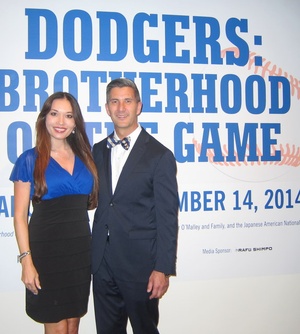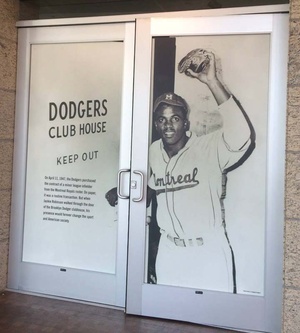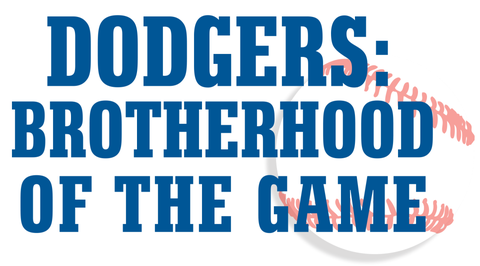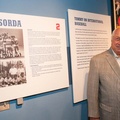It is difficult to remember any span of my childhood without thinking about baseball as the sentimental and grounding backdrop that has helped bond our mixed-race family together in Los Angeles. When the Dodgers played, it was an event that inspired in us a feeling of hope, celebration, and in the confidence of knowing that our multicultural home was always ready for center field, and with no apologies needed.
My siblings and I shared interesting parents who were from different cultural and ethnic backgrounds of Japanese, Russian-Jewish, and Irish, which meant that life was not always simple or easy-going. But our love of baseball, and especially for the Dodgers, helped us to forget that we “often felt like outsiders in our own community,” and to remember that we were worthy just as we were.
The exhibition, Dodgers: Brotherhood of the Game, on display at the Japanese American National Museum through September 14, reminds me of just why my family has rooted for the Dodgers for so many years, because in a way, we have always felt they have rooted for us.

Gallery of "Dodgers: Brotherhood of the Game" at The Japanese American National Museum (Photo by Vicky Murakami-Tsuda)
As trail blazers in the realm of community building, civil rights, and globalization, as well as in their unyielding commitment to “fair play,” watching the Dodgers has been a true pastime that has helped secure our family together through shared memories that will last for generations to come.
Greg Kimura, President and CEO of JANM, reflected this sentiment, “This exhibit is important for JANM because it is about being American and, increasingly, the power of sports to bring diverse folks together in a globalized world. It tells stories of character that transcends baseball and show us something special about the human spirit.”
“We are looking at the heart of what it means to compete and how seeing the success of people who look like the diversity that is America can be inspired and come together,” Kimura added.
How could we feel excluded as we watched a baseball team that has helped to continually break down the barriers and stereotypes of race and the bonds of exclusion? As a team and American symbol for inclusion, the Dodgers have proudly recruited players from different backgrounds in the public arena of sports, culture, and civil rights in a way that has changed the field of baseball, and life as we know it.
As a young kid, I rooted for “our team” with my native Angeleno father, a lifelong Dodgers fan who helped to instill in my family a feeling of unity and optimism, as baseball played a continual and grounding role in both the forefront and background of cultural unity that was our lives.
These are the moments when time seemed to stand still, as we listened to famed announcer Vin Scully tell the story of each game as if he were talking to each one of us personally. Every play, pitch, hit, and home run seemed to validate our unspoken and yet “knowable” knowledge that baseball, and especially the Dodgers, told our story as well; one of fearlessness, and the unyielding feeling that anything was indeed possible, as long as we had the courage to dream big.
My father, Les Biller, a Los Angeles artist and lifelong Dodgers fan, inspired in my family the appreciation for “the beauty and art of the game.” After viewing the exhibition, he said, “The Dodgers have always been in the forefront of making baseball an international, multiracial, and inclusive sport.”
“Baseball is full of interesting people and Vin Scully has done a great job in telling us the background and personal traits of players. The more you know about the players, the more enjoyable the game becomes. So a baseball game, a series, a season can become like a novel; think ‘War and Peace on the Baseball Diamond,’” Biller said.
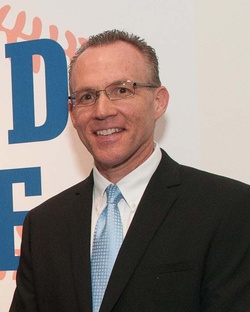
Mark Langill, Team Historian for the Dodgers and Curator of "Dodgers: Brotherhood of the Game" (Photo by Mike Palma)
Mark Langill, Team Historian for the Dodgers, said that he hopes the exhibition will appeal to all ages and backgrounds. “The history of the Dodgers franchise spans from Brooklyn to Los Angeles, with several international visits and exchanges along the way. The Japanese American National Museum provides an ideal setting to analyze and understand the team’s history, along with other significant baseball milestones,” Langill said.
While our family gathered around our television set that took center stage in our living room as we watched players like Hideo Nomo, Fernando Valenzuela, and Chan Ho Park play for the first time, we were simply enjoying the game of baseball. Never did I recall anyone in my family comment about the race of the players. Rather, it was “all about the excitement of the game.” Although Vin Scully did a masterful job of “storytelling” as he talked about the players’ backgrounds, it was in only the most respectful and casual manner, resulting in a colorful interest as opposed to any form of polarization or politicization of the game.
It was only much later as a young adult when I understood that we were witnessing “history in the making.” My first epiphany at how revolutionary the Dodgers were, was when my friend, who is Hispanic, told me that life actually got easier for him and his family after Fernando Valenzuela joined the Dodgers.
“It got to the point when kids were asking us to play ball with them for the first time,” Claudio said. “For us, Valenzuela became a hero, because he came out of nowhere it seemed, and he lived the American dream that we all wanted to experience.”
Kimura also commented on Fernando Valenzuela, who he calls “the first mega-star Mexican pitcher.” “Even as a kid in Alaska, I remember the fervor surrounding Fernandomania,” said Kimura. “And for me, the importance of Sandy Koufax who, in refusing to pitch the first game of the ’65 World Series because it fell on Yom Kippur, drew a lot of criticism. Now we understand him as a leader of minority religious rights—and the Dodgers won the Series in the end!”
For my family, any fears we held about our mixed cultural identity suddenly vanished each time we rooted for our favorite team. Simply put, being a Dodgers fan means being a “real-life supporter” of anything that authentically spells out words like home, belonging, comradely, and bravery—even when goals and actions are unpopular and may cause dissent and conflict.
“Sports is a way to feel American, a cultural entry-point, if you will,” said Kimura. “They are also, when fair play is a given, the ‘level playing field’ where it doesn’t matter who you are, your background, or your ethnicity. Talent, hard work, sportsmanship, character, and, probably a little bit of luck are all that counts. Baseball is iconic in this sense because it is traditionally America’s pastime.”
Truth be told, the Dodgers have helped to make sense of my life. Somehow, when our family of six watched our home team together, we were also rooting for ourselves as we witnessed much more than just a game, but an element of change insofar as a cultural renaissance and awakening, and in the reinvention and validation of our own identity.
Growing up, my father sentimentally recounted what the Dodgers meant to him, “Being a Dodger fan as a kid, I thought I had died and gone to Heaven when they moved to L.A. Then they had those truly great teams,” Biller said.
“As a boy going to the old ‘Hollywood Stars’ games were the greatest times I had; the joy of family which we try and replicate the rest of our lives. Baseball has so many meanings from the love of statistics to the complex chemistry among players, to the eternal hope of every Spring to having a winning club.”
When I first heard about the exhibition, my heart both raced and stood still at the same moment. As a huge fan, as well as a writer who chronicles both stories and history about Japanese cultural identity and multiculturalism, I awaited the show with excitement, anticipation, and curiosity.
My first thought was that this was a vast undertaking on the museum’s part. After all, the Dodgers means so much to so many people, and on so many emotional and visceral levels. Their unique stamp on the world of baseball and culture is one that is so historically iconic, I wondered how the exhibit would accurately tell their story.
But tell the story it does, and in a way that will both move and inspire anyone who cares about both “the human and humane” experience. This includes the universal aspiration that we all want to feel accepted for who we are at our core, and to feel a sense of belonging, no matter what color, creed, or sense of identity that we have or aspire to.
More importantly, the exhibit chronicles the story of a legendary organization that has consistently had the courage to make decisions in the name of baseball, changing American culture as we know it. In addition, it tells the story of Los Angeles as a community that is as multicultural as any can be, as its fans have encouraged and supported a team that has seen more changes than perhaps any other team in baseball history.
Through a unique collection of personal stories, historic photographs, and original artifacts, I was moved by the story of the Dodgers exhibit on a visceral level that only inspired me to learn more.
“By showcasing Dodgers: Brotherhood of the Game, we are able to tell the story of a team whose history is embedded in American history in a way no other sports team can claim,” Kimura said. “In the end, the exhibit is designed to appeal to fans of any team or no team. You don’t even have to care for baseball to see there is an important story about multicultural America here.”
According to Langill, “The principle subjects of the exhibit who wore a Dodger uniform are Jackie Robinson, Fernando Valenzuela, Hideo Nomo, Chan Ho Park, and Tommy Lasorda, all of whom brought unique backgrounds and perspectives to their craft when they embarked on their own careers.”
When I asked him to reflect on the historical role they have played in civil rights, Langill said, “When the Dodgers signed Jackie Robinson to a minor league contract in 1945, the transaction created a great debate within the industry and the United States because no African American in the 20th century had appeared in a Major League game.”
“The pressure felt by Robinson was unlike any other player, before or since,” he said. “Others like Hideo Nomo and Chan Ho Park made history as the first players from their respective countries; in the case of Nomo, the first Japanese pitcher in the Majors in 30 years. Whether based in Brooklyn or Los Angeles, the Dodgers became trail blazers, thanks to the combination of Robinson’s success and the team’s continued involvement with the international baseball community.”
* * * * *
Japanese American National Museum
March 29 through September 14, 2014
Dodgers: Brotherhood of the Game will give visitors the opportunity to look beyond the statistics and the memorable performances on the field. Baseball fans and those new to the game will gain an understanding of the importance of these players and the Dodgers’ role in shaping American culture, contributing to advancements in civil rights, and promoting international baseball.
© 2014 Francesca Biller


